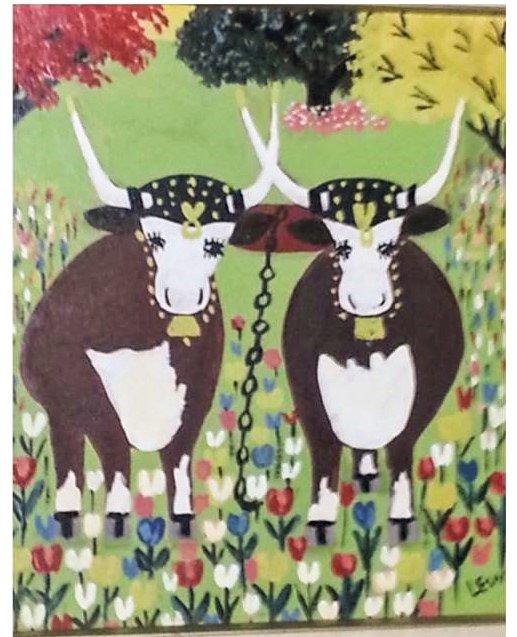RCMP on hunt for pair of stolen Maud Lewis paintings
Advertisement
Read this article for free:
or
Already have an account? Log in here »
To continue reading, please subscribe:
Monthly Digital Subscription
$1 per week for 24 weeks*
- Enjoy unlimited reading on winnipegfreepress.com
- Read the E-Edition, our digital replica newspaper
- Access News Break, our award-winning app
- Play interactive puzzles
*Billed as $4.00 plus GST every four weeks. After 24 weeks, price increases to the regular rate of $19.00 plus GST every four weeks. Offer available to new and qualified returning subscribers only. Cancel any time.
Monthly Digital Subscription
$4.75/week*
- Enjoy unlimited reading on winnipegfreepress.com
- Read the E-Edition, our digital replica newspaper
- Access News Break, our award-winning app
- Play interactive puzzles
*Billed as $19 plus GST every four weeks. Cancel any time.
To continue reading, please subscribe:
Add Winnipeg Free Press access to your Brandon Sun subscription for only
$1 for the first 4 weeks*
*$1 will be added to your next bill. After your 4 weeks access is complete your rate will increase by $0.00 a X percent off the regular rate.
Read unlimited articles for free today:
or
Already have an account? Log in here »
Hey there, time traveller!
This article was published 20/12/2021 (1373 days ago), so information in it may no longer be current.
HALIFAX—Anyone trying to fence two stolen paintings by renowned Canadian folk artist Maud Lewis has a harder job ahead of them, after the Nova Scotia RCMP made their theft public Monday.
The paintings, estimated to be worth $20,000 apiece, were stolen Sept. 10 from a private residence in Smiths Cove, N.S., about two hours west of Halifax, police said. Nothing else was stolen from the house during the burglary.
Attempts to locate the paintings thus far have proved fruitless, and the RCMP are hoping that making the theft public and releasing photographs of the paintings will garner them a few leads.

“If someone has seen this post … and they do notice someone trying to sell them, I would hope that they would call the police and give us that information,” said RCMP spokesperson Lisa Croteau.
The announcement is likely to have a cooling effect on potential sales of the stolen artwork, as the first thing gallery owners or auctioneers will do when presented with a Maud Lewis painting is some provenance research, said Shannon Parker, the Laufer curator of collections at the Art Gallery of Nova Scotia.
In the case of this pair of paintings, that research would quickly turn up the fact that they had been stolen.
Lewis, a reclusive Nova Scotia folk artist, was born in Yarmouth and lived in a small house in Marshalltown in western Nova Scotia from the time of her marriage to husband Everett in 1938 until her death in 1970. A progressively worsening case of rheumatoid arthritis limited her mobility and made painting gradually more difficult in her later days.
Despite that, she produced hundreds of paintings, generally simple, cheery, colourful, somewhat nostalgic scenes of her home province.
Notwithstanding a surge of interest in her work in the mid-60s — a time when she raised prices on her paintings to $5 from the $2-$3 she had been charging — Lewis was still poor at the time of her death.
Another surge of interest in her work in the mid-90s, followed by a film based on her life in 2016 led to global interest in Lewis and her paintings, from as far away as Australia and Japan.
“A lot of people find them very attractive,” said Parker, explaining Lewis’s popularity. “They’re straightforward. (They use) a lot of primary colours; they’re whimsical and have a bit of a sense of humour.
“And then, layered on top of that, is the knowledge that you have this woman who was disabled and had a pretty miserable life, but created these bright, colourful paintings, and a lot of people respond very emotionally to them.”
The stolen paintings, in typical Lewis fashion, are straightforward, simple compositions making liberal use of primary colours. Both feature a pair of oxen, one with a winter background, the other with a summer background.
The oxen were among Lewis’s favourite subjects, so much so that she often used stencils to reproduce them from painting to painting, said Parker,
“She would often paint a very similar scene over and over again with minor adjustments,” said Parker. “It was a time-saving tool, but it was also a tool that helped her with her more limited mobility.”
Parker said the vast proportion of Lewis’ paintings are currently in the hands of private owners, some of whom may or may not know the value of what they possess.
But the artworks continue to grow in value. In 2016, one of her paintings sold at auction for $45,000, and a number of others have been auctioned at prices in excess of $20,000.
Steve McKinley is a Halifax-based reporter for the Star. Follow him on Twitter: @smckinley1

